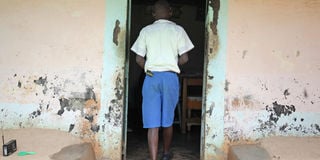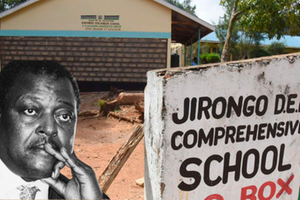HIV drugs have failed twice but I won’t give up

Elias Opiyo at their home in at Kotie village, Rongo Sub-county, Homa Bay County.
What you need to know:
- Elias is just one of 78 young people in Kenya who are on the third-line drugs
- In Homa Bay County there are 17, who have had to deal with the consequences of drug shortage
- When the third-line drugs are not available in the country, the children are placed on a waiting list or on an alternative drug
- A patient is considered virally suppressed when the viral load copies in the body is less than 1,000
It is noon when we arrive at their home in Kotie village, Rongo Sub-County, Homa Bay County.
Elias Opiyo will be home for lunch any minute now.
At exactly 12:30pm, a group of pupils walks into the compound chatting animatedly.
The pupils disappear one by one into their homes and the boy who walks towards us looks nothing like an 18-year-old.
“Are you Elias?” I ask.
He smiles on seeing the look on our faces. “Yes, I am. I know why you are asking,” he says.
“I know you were expecting me to be bigger than I look. My body can be deceiving. Although I am small, I have a sharp mind.”
At 43kg, Elias has always been smaller than his peers. “It is not because of my genes. I have had frequent disease attacks. I have been in and out of school. I have just sat the KCPE examination. Had I not missed school, I would have been completing my O’ levels now,” he tells HealthyNation.
Born to an HIV-positive mother in 2003, Elias has been at the mercy of opportunistic infections, from meningitis, tuberculosis to pneumonia.

Elias Opiyo studies outside their home.
His antiretroviral (ARV) treatment has failed two times, thanks to caregivers, who ignored drug schedules. Lack of food and drug stockouts also hindered treatment.
Elias is currently on the third-line ARV regimen, having failed the first and second. He hopes the drugs do not fail since he does not have the strength to start treatment afresh.
No improvement
The symptoms kicked in after his mother’s death. He began developing wounds all over his body, had a protruding stomach and frequent diarrhoea.
He was admitted to hospital for two weeks and discharged with drugs after showing no signs of improvement.
His grandmother, who was his caregiver, took him to various hospitals but he only got worse. A healthcare provider in a local dispensary recommended an HIV test.
It took one year before he got tested. Meanwhile, Elias was getting worse.
In November, 2005, at the age of two, he was bedridden.
They needed an answer. He was tested for HIV at Homa Bay Teaching and Referral Hospital and the results were positive.
He was started on Stavudine, Lamivudine and Efavirenz ART in April, 2006. In 2010, after four years of taking the drugs, they were substituted with Zidovudine, Lamivudine and Nevirapine as per the national recommendation. The government was phasing out Stavudine.

Elias Opiyo is on third-line HIV treatment.
At the time of enrolment he was 15kg and had good weight gain through to 2016 until 34kg. He stagnated at that weight from 2016 to 2018. In 2018, he added 10kg. But, a TB diagnosis made him lose weight.
At home, nobody helped him stay on course. He lived with his grandmother, who did not know he was HIV positive and therefore did not help him adhere to the treatment.
“My brother was the only one who knew I was HIV positive. He did not tell us. I would take the drugs whenever I felt like. When the drugs were over, I would go for days without informing him to go for a refill,” he recalls.
“Since my grandmother did not know why I was taking my medicine, she was not keen on the timing.”
Due to this, he developed meningitis. He was admitted to hospital for two weeks.
Elias was monitored for six months. A test revealed his viral load was 286 times more than the recommended 1,000 copies. The first-line drugs were failing.
The health care providers recommended a second-line regimen.
Resistance to the first-line regimen means they have failed or the patient cannot tolerate the drugs. The patient is then put on much more expensive second-line therapy.
High viral load
When the second-line regimen fails, the patient graduates to third-line drugs. However, resistance always reduces patients’ options in each stage and is very costly for countries.
In March 2012, Elias was put on second-line regimen Abacavir, Lamivudine and Lopinavir/Ritonavir.
For three years they worked well until a Lopinavir stockout hit. He was placed on a different drug and it worked for some time. However, at some point he started developing complications.

Elias Opiyo, who is HIV positive.
His viral load had reduced to 9,520 copies. At that time, he weighed 30kg. The viral load still worried health experts.
The experts recommended that a resistance test be done to identify the drugs that were not working for him.
From the result, Elias was developing a low-level resistance mutation to Darunavir and high-level resistance to Lopinavir and Atazanavir. He failed the second-line treatment.
He got another attack that rendered him motionless. He could not walk and had to be taken care of by his brother.
“When I realised I was going to lose my brother, I took him in and started monitoring how he was taking his drugs,” his brother, Voctor Ochieng, tells HealthyNation.
Dr Jacob Bulimo, the Elizabeth Glaser Pediatric Aids Foundation Senior Technical lead HIV care and treatment, says the switch to different regimen is a thorough process that involves many experts.
After a patient tests positive, they are placed on treatment immediately and registered on a first-line regimen. After six months, a viral load test is done, to check whether the patient is responding well to the drugs.
“If the viral load is more than 1,000 copies per ml, then definitely there is a problem. There could be non-adherence to medication, lack of caregiver support, poor clinic visits and even stockouts. We tease out everything and move to non-adherence counselling training,” he says.
The counselling is conducted in three phases, spaced within three months. After three months, the assumption is that the patient has been taking the drugs and counselling on the barriers has been tackled.
A repeat of the viral load test is then done after the three months, in case of a failure, then the patient is eligible to proceed to the second-line regimen.

A girl who is on third-line HIV treatment.
The decision is made at the facility level by a multidisciplinary team. The team goes through the patient’s profile and decides whether they are eligible for the second-line regimen.
Drug resistance test
But, should the second-line treatment fail, and the viral load is still high, then a case summary of the patient is done by the facility and sent to technical experts who will point out barriers the facility has not tackled.
A recommendation is done on whether the patient needs support to take medication. In case of children, they are enrolled in the Mwangalizi concept, where they are attached to a different caregiver, a neighbour or a relative to support in the ingestion of the drugs.
“If the patient fails again, the matter is cascaded to a multi-disciplinary team for a decision. The team then recommends a drug resistance test to inform the system whether the patient has developed a mutation in any of the drugs they are using,” he adds.
While the team waits for the results, a daily witness ingestion of the drug is introduced for two weeks to monitor the progress.
After six months of change of drugs, another viral load test is done to tell whether the patient is responding well to the third-line treatment.
“With the help of the technical experts, they then determine whether the patient should be placed on third-line regimen by recommending the drug to be given to the patients and also pointing out which ones are developing mutation,” he says.
In the event that the patient will not have suppressed the virus, the same process will be repeated and they are placed on a different regimen.
A patient is considered virally suppressed when the viral load copies in the body is less than 1,000 and considered stable if it is less than 1,000 constantly for more than 12 months.
Dr Bulimo says all the processes were performed in Elias’ case and he still failed the second-line treatment. By the time Elias was being placed on the third-line regimen, his viral load had shot to 225,000 copies.
He was not responding at all to treatment.
Last year in October, Elias was placed on the third-line regimen of Tenofovir Lamivudine and Dolutegravir.
Pandemic disruptions
At the same time, the country was experiencing a shortage of certain third-line molecules - Darunavir, Raltegravir and Etravirine, which could be an alternative for Elias should his current drugs fail.
The stockouts, according to Dr Gordon Okomo, the Homa Bay County director of health services, were majorly due to a disruption caused by the pandemic.
“When we have a stockout and someone comes to the hospital for a refill, chances that they will come the next day for the same drug are minimal. The missed opportunity arises and this could also be causing the failure of drugs,” adds Dr Okomo.

A girl who is on third-line HIV treatment.
With the pandemic, the county lost contact with 160 HIV patients, the system was disrupted and the priority shifted to the coronavirus.
Due to this, high-traffic facilities transferred patients to facilities they were not used to, affecting how they collect their drugs. “There was disruption and this could also contribute to the failure of the drugs,” he said.
Elias is just one of 78 young people in Kenya who are on the third-line drugs. In Homa Bay County there are 17, who have had to deal with the consequences of drug shortage and at some point have waited for their drugs for months.
In Homa Bay, around 115,000 are on treatment of which 97,000 are on first-line treatment for adults and 6,647 children, 16 per cent on second line and 25 children are on third-line treatment.
When the third-line drugs are not available in the country, the children are placed on a waiting list or on an alternative drug that might compromise their viral load.
However, Elias and the rest have another problem awaiting them and it could lead to resistance should the government and USAid fail to on the release of the drugs that have been stuck at the Port of Mombasa.
Stuck at the port, as per the documents, are 258,954 packs of Tenofovir, Lamivudine Dolutegravir.
These are the same drugs that Elias is currently using. Already, the Health Ministry had announced a stockout and the US has since announced it is considering moving the drugs to other countries.
USAid cited the shelf life of the drugs and the accruing storage charges, stating that already, it amounts to a total of over one-quarter of the cost.
According to research done in Kenya and published in the online edition of Aids and the Lancet, affordable third-line antiretrovirals are urgently needed in resource-limited settings.
It indicates that nearly one in four patients in Kenya are failing second-line treatment and have complete exhaustion of available antiretrovirals hence the need for increased access to third-line treatment in the country.
The study showed only 18 per cent had a virus that was fully susceptible to the three main classes of anti-HIV drugs. The research stated that 27 per cent of patients who were on second-line treatment and have failed needed to switch to third-line drugs.


